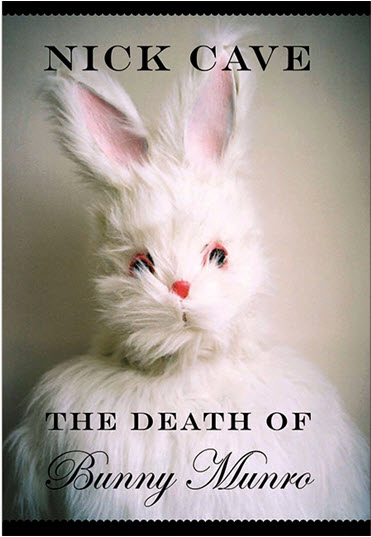 As already hyped over the Net, Nick Cave (the multitalented Australian singer, screenwriter, actor, writer and what have you) is releasing his second book The Death of Bunny Munro. Surrounding the presentation of his new book, Cave, assisted by publisher Canongate, is launching a huge marketing campaign using all digital/new media marketing possibilities to promote Bunny. This viral operation, combined with the aura surrounding Cave, makes this a very interesting endeavor to take a closer look at.
As already hyped over the Net, Nick Cave (the multitalented Australian singer, screenwriter, actor, writer and what have you) is releasing his second book The Death of Bunny Munro. Surrounding the presentation of his new book, Cave, assisted by publisher Canongate, is launching a huge marketing campaign using all digital/new media marketing possibilities to promote Bunny. This viral operation, combined with the aura surrounding Cave, makes this a very interesting endeavor to take a closer look at.
First of all, what is the book about? From the publisher’s website:
“The Death of Bunny Munro recounts the last journey of a salesman in search of a soul. Following the suicide of his wife, Bunny, a door-to-door salesman and lothario, takes his son on a trip along the south coast of England. He is about to discover that his days are numbered. With a daring hellride of a plot The Death of Bunny Munro is also a modern morality tale of sorts, a stylish, furious, funny, truthful and tender account of one man’s descent and judgement. The novel is full of the linguistic verve that has made Cave one of the world’s most respected lyricists. It is his first novel since the publication of his critically acclaimed debut And the Ass Saw the Angel twenty years ago.”
I have not (yet) read Cave’s first novel (mentioned above) but love his song writing, and although, as novelist Will Self states in his amazing review on Cave as a writer, writing good song lyrics is not the same as writing a good book or poem, Self (with me agreeing – I hope) seems to make an exception when it comes to Cave. From his review, entitled Dark Matter (originally published in The Guardian):
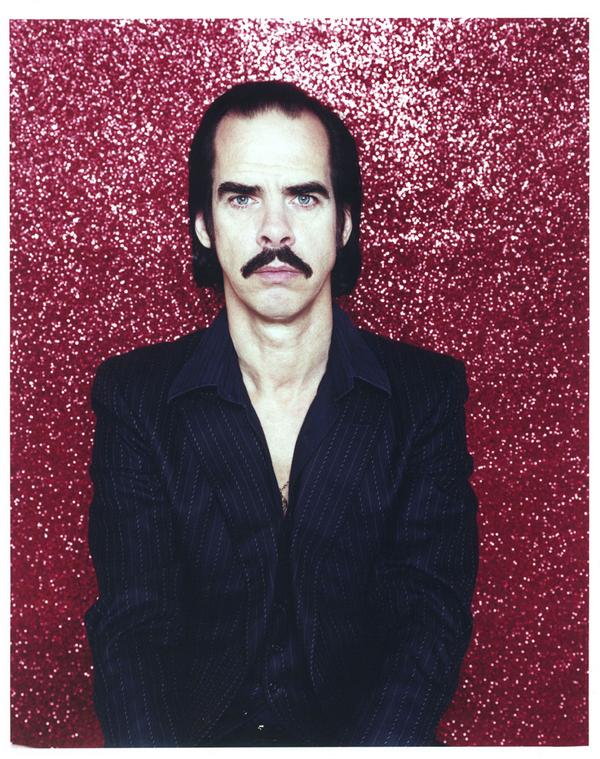 “Cave, as a poetic craftsman, provides all the enjambment, ellipsis and onomatopoeia that anyone could wish for. A word on eroticism and the dreadful dolour of knowing not only that all passion is spent – but also that you’re overdrawn. If Cave were to be typified as a lyricist of blood, guts and angst, it would be a grave mistake. He stands as one of the great writers on love of our era. Each Cave love song is at once perfumed with yearning, and already stinks of the putrefying loss to come. For Cave, consummation is always exactly that.”
“Cave, as a poetic craftsman, provides all the enjambment, ellipsis and onomatopoeia that anyone could wish for. A word on eroticism and the dreadful dolour of knowing not only that all passion is spent – but also that you’re overdrawn. If Cave were to be typified as a lyricist of blood, guts and angst, it would be a grave mistake. He stands as one of the great writers on love of our era. Each Cave love song is at once perfumed with yearning, and already stinks of the putrefying loss to come. For Cave, consummation is always exactly that.”
This promises quite a lot and the fact that Cave’s writing skills extend to prose does not surprise me, although it does make one a little envious of such an unlimited talent.
Published by Canongate, the UK publication of Bunny is planned for September 3rd 2009. Accompanying the book release a beautifully designed website has been created, on which one can (of course) find more information about the book, reviews (reviews from the Australian release are already up here) and information about the events surrounding the release. As this is an international release, being published in 31 countries around the world, these events are an important part of the campaign. Cave is doing webchats, interviews, evenings and talk sessions all over the world. These events will not only gather there own revenue but will definitely also promote the sales of the book. Cave is also booked to come to Amsterdam, states his Dutch publisher J.M. Meulenhoff: On the 14th of October Cave will ‘do’ the renowned venue Carré (an evening with Nick Cave) – press interviews afterwards. Knowing these Carré events, tickets will probably go for around 100 euros. Good plan Nick.
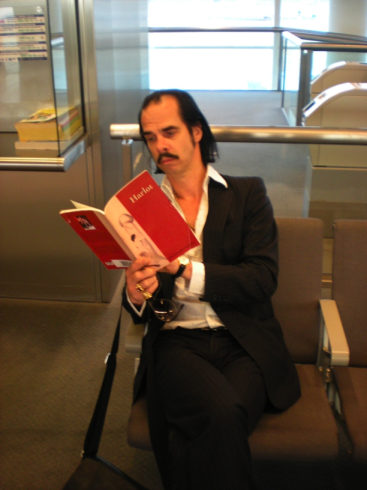 Still, nothing out of the ordinary here. What makes this such an interesting multimedia release however is the fact that Cave simultaneously releases an audiobook version, read by the man himself, with an accompanying soundtrack created by Cave and Warren Ellis (who worked before with Cave on The proposition and in his Grinderman project). The soundtrack uses a ‘3D audio spatial mix’, specially designed for listening on headphones and thus, as the website states ‘creating a fully immersive experience for the listener’. Next to that one can also find videos on the Bunny site (and on Youtube) showing Cave reading from the book (detail: notice bling-bling rings on fingers) – again accompanied by the aforementioned soundtrack: all creating the necessary buzz around the persona or brand of Cave. I watched some of it, and, in a part which recalls a kind of absurdist Ellis, I especially liked chapter 11 part 1.
Still, nothing out of the ordinary here. What makes this such an interesting multimedia release however is the fact that Cave simultaneously releases an audiobook version, read by the man himself, with an accompanying soundtrack created by Cave and Warren Ellis (who worked before with Cave on The proposition and in his Grinderman project). The soundtrack uses a ‘3D audio spatial mix’, specially designed for listening on headphones and thus, as the website states ‘creating a fully immersive experience for the listener’. Next to that one can also find videos on the Bunny site (and on Youtube) showing Cave reading from the book (detail: notice bling-bling rings on fingers) – again accompanied by the aforementioned soundtrack: all creating the necessary buzz around the persona or brand of Cave. I watched some of it, and, in a part which recalls a kind of absurdist Ellis, I especially liked chapter 11 part 1.
You can buy or order different formats of the book: the signed, numbered and slipcased limited edition (up to 120 pounds and increasing with every sale – real fans buy everything). The standard hardback, the ebook in EPUB format, an audiobook box set (with DVD of Cave reading extracts from the book) and an audio download will also be available. This multimediality offers the reader all kinds of entrances into the narrative, providing choice and convenience. The Guardian zooms in on this aspect in a very good analysis of these kinds of ‘enhanced book editions’ that will be available for the iPhone:
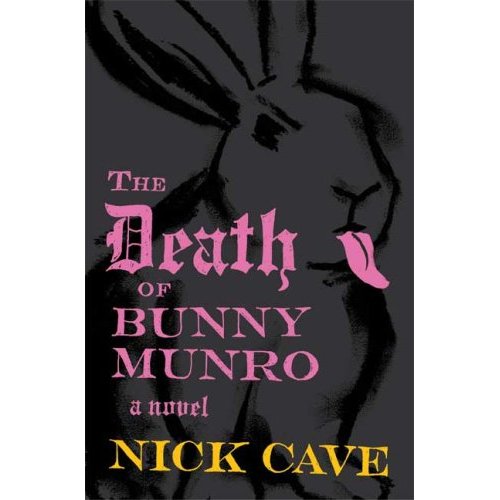 “The Enhanced Edition does some of the things we’re now accustomed to seeing as standard in electronic texts: you can faff with fonts, change colour, bookmark it, and so on; and there’s some smart social networking stuff attached. But it also includes enhancements that could have a noticeable effect on the experience of reading. Instead of paginating the book conventionally, it’s presented as a continuous vertical scroll (one geek-pleasing trick is that you can adjust the scrolling speed with the angle of tilt of the phone), and the App includes an audiobook that syncs with the written text. Pop on the headphones, thumb the screen and Cave’s voice picks up where you left off.”
“The Enhanced Edition does some of the things we’re now accustomed to seeing as standard in electronic texts: you can faff with fonts, change colour, bookmark it, and so on; and there’s some smart social networking stuff attached. But it also includes enhancements that could have a noticeable effect on the experience of reading. Instead of paginating the book conventionally, it’s presented as a continuous vertical scroll (one geek-pleasing trick is that you can adjust the scrolling speed with the angle of tilt of the phone), and the App includes an audiobook that syncs with the written text. Pop on the headphones, thumb the screen and Cave’s voice picks up where you left off.”
The Guardian seems very enthusiastic about the possibilities these kinds of experiments might bring to our reading experience: making it less monolithically text based and more immersed with our other senses, experiencing mixed media at the same time, as we are increasingly more used to nowadays anyway:
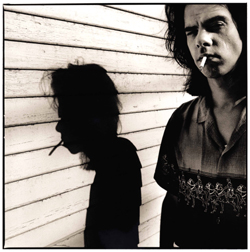 “This is interesting. It could be regarded as a gimmick, but if it catches on, it will subtly change the way we experience fiction. If you half-read, half-listen to a book, your experience of reading will partly be shaped by the voice of the audiobook; your memories of the text will be coloured by how you took it in, passage by passage. (…) So, some whiffs of roses and haddock. But the breadth of the package, it seems to me, is at the very least a weathervane. There’s no ignoring the fact that the e-book will, not too far from now, compete with the paperback; and the likelihood is that some readers won’t just use them to read. It’s a longstanding truism to say that every reader reads a different book. As more packages like this find their way to market, the book itself, as well as its readings, will become more plural, more blurred, and less monolithically booky. Smells good to me.”
“This is interesting. It could be regarded as a gimmick, but if it catches on, it will subtly change the way we experience fiction. If you half-read, half-listen to a book, your experience of reading will partly be shaped by the voice of the audiobook; your memories of the text will be coloured by how you took it in, passage by passage. (…) So, some whiffs of roses and haddock. But the breadth of the package, it seems to me, is at the very least a weathervane. There’s no ignoring the fact that the e-book will, not too far from now, compete with the paperback; and the likelihood is that some readers won’t just use them to read. It’s a longstanding truism to say that every reader reads a different book. As more packages like this find their way to market, the book itself, as well as its readings, will become more plural, more blurred, and less monolithically booky. Smells good to me.”
Well, I am ready for the experience and will try to read the book simultaneously with the audiobook; as I am a fast reader I wonder if Nick can keep up with me, but maybe the rich baritone of his voice will keep my eyes gripped on the words a little longer.